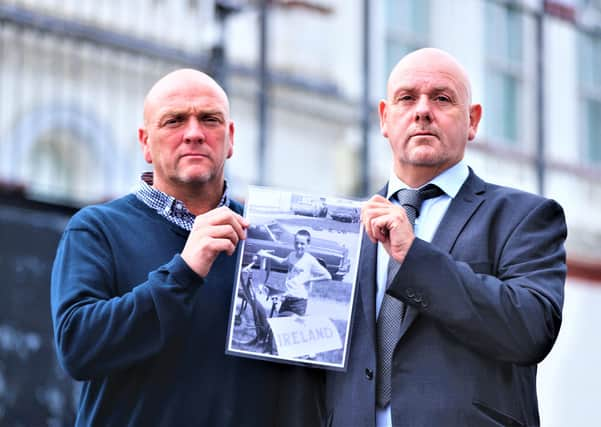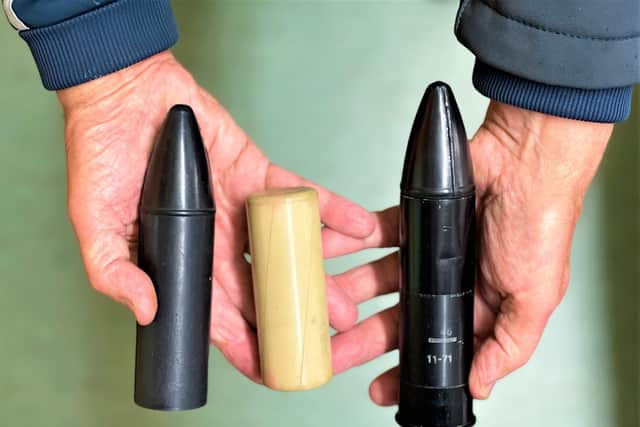Child (10) struck on head during 1975 disorder ‘thought he had been hit with catapult’


A 10-year-old boy was found lying on the ground immediately after a plastic baton round was discharged by a soldier near a barricade in west Belfast in 1975, an inquest has been told.
A coroner has begun hearing the case relating to the death of Stephen Geddis, who suffered a head injury on August 29, 1975.
He later died.
Advertisement
Hide AdAdvertisement
Hide Ad

The legacy inquest is one of a number ordered by former Northern Ireland attorney general John Larkin.
Opening the inquest at Banbridge Court, Frank O’Donoghue, counsel for the coroner, set out the background to Stephen’s death.
He referred to a post-mortem examination which was carried out the following morning.
Mr O’Donoghue said the report stated that an unauthorised barricade had been set up by civilians in Albert Street on the evening of August 29 1975, that there was a crowd of 40 to 50 youths around the barricade, and that stones and missiles had been thrown at soldiers.
Advertisement
Hide AdAdvertisement
Hide AdHe said the report stated that one soldier moved forward and fired a plastic bullet.
When the crowd dispersed, a boy was seen lying on the ground.
Stephen was taken to the Royal Victoria Children’s Hospital, where, according to the post-mortem report, he told nurses he had been hit on the head by an object fired from a catapult.
Mr O’Donoghue told the hearing that the inquest would call as witnesses three soldiers from B Company of the Second Royal Anglian Regiment, referred to as SGM3, SGM15 and SGM12, who were on patrol that evening.
Advertisement
Hide AdAdvertisement
Hide AdMr O’Donoghue said: “One matter I should raise at this time is the reliability of the history apparently given by Stephen in hospital that he was apparently hit by a catapult.
“This court is going to receive evidence from at least two pathologists. One matter about which pathologists do appear to be in agreement is that Stephen’s injuries are much more consistent with being struck by a plastic baton round than any object fired from a catapult.
“I am flagging up to the court that it may be that the possibility of Stephen suffering his head injury as the result of a discharge from a catapult can be eliminated and the pathology evidence will weigh firmly in favour of Stephen having suffered his injury as a result of a blow from a plastic baton round.”
He continued: “It is anticipated that the court will hear evidence from a number of civilian witnesses who will testify as to what they heard and saw that evening, and from relevant Army personnel who are members of B Company of the Second Royal Anglian Regiment and who were on patrol that evening.
Advertisement
Hide AdAdvertisement
Hide Ad“As the facts of what did occur are significantly in dispute, I will say merely at this time that it appears that a group of young boys gathered in the vicinity of a barricade that had been erected in the Albert Street / Cullingtree Road area.
“There is an issue as to whether Stephen is part of or separate from that group.
“It would appear that those young boys engaged in some acts of civil disorder, but the extent of those acts appears to be in dispute.
“It would appear that there were two baton rounds discharged.
Advertisement
Hide AdAdvertisement
Hide Ad“One baton round appears to have been discharged which had the effect of dispersing part of the group.
“The second baton round appears to have been discharged at a later point in time and again the circumstances of that appear to be very much in dispute.
“What does not appear to be in dispute is that, in the immediate aftermath of the second baton round being discharged, Stephen was found lying on the ground with the injury to his head.
“We anticipate hearing evidence demonstrating that Stephen was found lying on the ground in the immediate aftermath of the discharge of the second baton round, and we appear to have pathology evidence that his injury is consistent with being struck by an object consistent with it being a plastic baton round.”
The inquest is being heard by coroner Paddy McGurgan.
MORE FROM THE NEWS LETTER:
Advertisement
Hide AdAdvertisement
Hide Ad> Transformation of Belfast city centre takes next big step as whopping 724-room student block gets OK <
Advertisement
Hide AdAdvertisement
Hide AdA message from the Editor:
Thank you for reading this story on our website. While I have your attention, I also have an important request to make of you.
With the coronavirus lockdown having a major impact on many of our advertisers — and consequently the revenue we receive — we are more reliant than ever on you taking out a digital subscription.
Advertisement
Hide AdAdvertisement
Hide AdSubscribe to newsletter.co.uk and enjoy unlimited access to the best Northern Ireland and UK news and information online and on our app. With a digital subscription, you can read more than 5 articles, see fewer ads, enjoy faster load times, and get access to exclusive newsletters and content. Visit https://www.newsletter.co.uk/subscriptions now to sign up.
Our journalism costs money and we rely on advertising, print and digital revenues to help to support them. By supporting us, we are able to support you in providing trusted, fact-checked content for this website.
Ben Lowry, acting editor